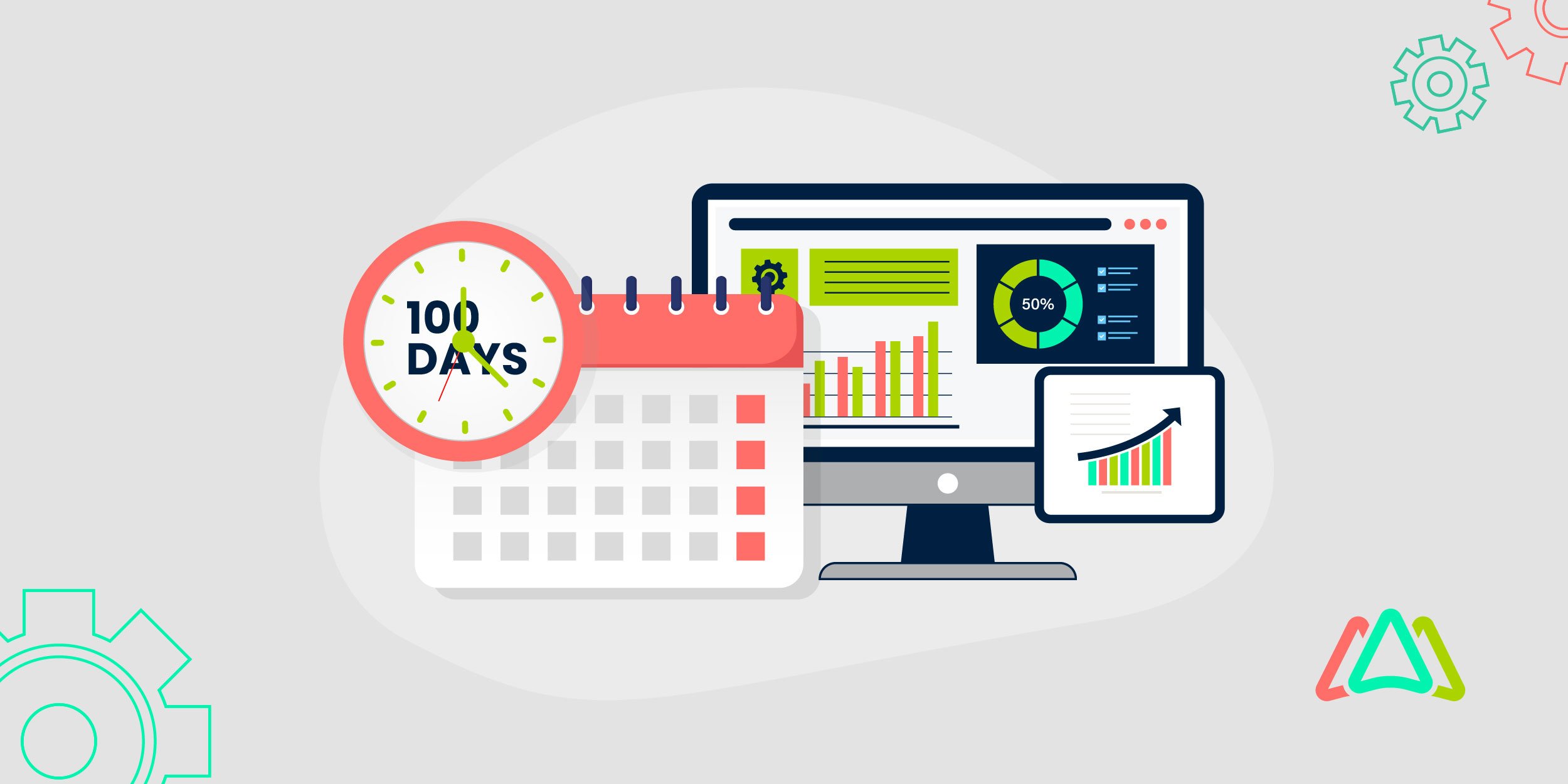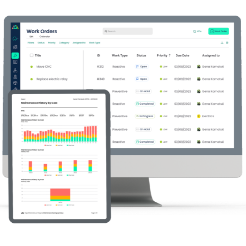
Your First Year with a CMMS: Evolving Beyond the 100‑Day Plan
Whenever a company introduces a new process or technology, it’s followed by a period of transition, adjustments, and a few hiccups before long-lasting benefits are realized. This is also the case when organizations implement a Computerized Maintenance Management System (CMMS), when much of the initial focus centers on the “first 100 days”. This is the time when all of the foundational work is done: onboarding teams, inputting data, establishing workflows, and securing buy-in. These crucial steps represent just the beginning of a much longer journey to improved efficiency and cost-saving operations. The CMMS implementation should be regarded as a living, evolving process that continues well into the first year and well beyond.
The first year with a CMMS should be viewed as an upwardly rising arc, beginning with stabilization and then quickly moving into process optimization, scalability, and performance tracking. Maintenance teams that adopt a realistic mindset of a year-long process tend to see higher CMMS adoption rates, improved preventive maintenance compliance, and a measurable ROI within 12–18 months, according to a 2023 report by Reliable Plant (Reliable Plant, 2023).
In this article, we’ll walk you through a phased approach to your first year with a CMMS, helping you not only have a successful implementation but also excel beyond it.

Phase 1: The Quick Wins (Days 1–100)
The goal of the first 100 days with a CMMS Software is to establish momentum. The point is to capture the attention of team members, convince them of a CMMS’s potential and secure their willingness to adopt the software. With a limited track record, this phase focuses on achieving visible and achievable wins that build confidence in the system and lay the groundwork for continued adoption.
The process begins by assessing your current maintenance landscape, identifying the most common pain points, such as frequent equipment breakdowns, missed preventive maintenance (PM) tasks, or poor work order tracking. This sets the stage for customizing a CMMS to your organization’s needs and objectives. The next step involves entering and validating asset data, setting up basic PM schedules, and creating standardized work order templates.
During this phase, it's crucial to involve your maintenance team—technicians, supervisors, and planners—in key setup decisions. Engaging them at this point fosters a sense of ownership and improves long-term adoption. The Society for Maintenance & Reliability Professionals (SMRP) recommends establishing clear communication channels and small pilot groups to ease change management and reduce resistance. As a final step in this initial phase, configure CMMS dashboards with real-time data on open work orders, overdue tasks, and PM completion rates to create early visibility. When team members and leadership can see their maintenance operations in action, it reinforces the value of the CMMS and validates that the system is being set up for success.
Phase 2: Building the Backbone (Days 101–180)
With the CMMS foundation in place, the next phase focuses on building out the system’s core structure that will support its long-term effectiveness. This includes refining preventive maintenance (PM) schedules, aligning workflows with actual technician behavior, and ensuring that all of the data—especially asset hierarchies, spare parts lists, and vendor information—is accurate and consistently maintained.
This phase provides an ideal opportunity to introduce more advanced features such as priority-based work orders, parts reordering triggers, and condition-based maintenance. Most importantly, data hygiene becomes a significant focus at this time because having clean, structured data is critical for producing trustworthy reports and meaningful KPIs later on. Training during this stage extends beyond basic navigation with an emphasis on role-specific instruction for planners, technicians, and managers. Training at this level enables each group to utilize the system to its fullest potential. Building this operational backbone ensures your CMMS doesn’t just function—it thrives.
Phase 3: Scaling and Embedding (Days 181–270)
At this point, you’ve arrived at the midpoint of the first year with a CMMS, and your organization should begin shifting from setup and stabilization to scaling and embedding the system into everyday operations. The focus of this phase is on integrating the system across departments and expanding its functionality to support more sophisticated maintenance strategies. For example, integrations with inventory management systems, procurement platforms, or IoT-enabled sensors to support condition-based maintenance are a few suggested integrations. You may also consider expanding user access to include contractors or external service providers. Doing so can streamline communication and work order completion.
As CMMS usage becomes more deeply embedded in maintenance operations, it's critical to ensure that performance metrics align with your organization’s goals. Tracking key indicators such as mean time to repair (MTTR), planned maintenance percentage (PMP), and maintenance cost per asset is also essential. Reviewing and updating workflows based on real-world usage, ensuring that the system continues to match how teams work, are worthwhile considerations at this time.
Phase 4: Continuous Improvement (Days 271–365)
Phase Four marks the closing days of CMMS implementation during the first year. And with that, the emphasis should be on continuous improvement. In other words, the software’s use should not be limited to managing maintenance tasks, but also to guiding strategic decisions. At this stage, your CMMS should be generating sufficient and reliable data to identify trends, pinpoint chronic failures, and support root cause analysis (RCA). Maintenance teams can use this information to optimize PM frequencies, reduce reactive work, and even begin implementing reliability-centered maintenance (RCM) practices. Regular performance reviews, ideally when conducted quarterly, can help validate the effectiveness of existing workflows and uncover areas for refinement. This is the time to make small changes as needed.
This last quarter is also a time to recognize milestones, such as reductions in emergency repairs or improvements in PM compliance. Recognizing these events reinforces user engagement and demonstrates ROI to leadership. As the CMMS becomes increasingly embedded in day-to-day operations, the maintenance team will continue to shift from reacting to issues toward proactively improving asset performance and extending equipment life. These efforts will set the stage for long-term success and sustainability.
Key Success Strategies Throughout the Year

Achieving success with a CMMS extends far beyond simply installing software, as that alone cannot accomplish what is needed. Success is all about driving adoption, building confidence, and aligning people, processes, and technology to achieve optimal outcomes. With that in mind, one of the most critical success factors is change management. From the outset, it’s essential to communicate clearly with your team about why the CMMS is being implemented, what it aims to achieve, and how it will make their jobs easier. Regular check-ins, open forums for feedback, and visible leadership support can significantly reduce resistance and encourage engagement. Technicians need to feel heard and see that their input leads to tangible improvements.
Equally important is developing a training strategy that can evolve with time. It begins with initial onboarding but should be followed by role-specific and refresher sessions to ensure continued proficiency as new features are introduced. Most helpful are bite-sized, hands-on learning opportunities—like tool tips, job aids, or lunch-and-learns. These brief learning opportunities help reinforce skills without overwhelming busy teams. A strong governance framework is also essential and may include forming a steering committee or working group that facilitates coordinated decision-making on priorities, system updates, and policy enforcement. And finally, investing in documentation from the start goes a long way. Whether it’s a CMMS playbook, standard operating procedures (SOPs), or decision logs, well-maintained documentation ensures consistency, accelerates onboarding of new staff, and serves as a reference during audits or system upgrades. When these strategies are applied consistently, they lay the foundation for a CMMS that delivers value not just in the first year, but for years to come.
Avoiding the Common Pitfalls
While the benefits of a CMMS are significant, there are a few pitfalls that should be avoided during the implementation phases. In general, many organizations experience unnecessary roadblocks by underestimating the challenges involved in successful implementation. One of the most common pitfalls is poor data quality; in other words, importing incomplete or inaccurate asset, inventory, or maintenance history data leads to unreliable reports and erodes trust in the system.
Another frequent mistake is overlooking technician feedback. Ignoring technicians' concerns and leaving them feeling frustrated, they may conclude that the CMMS creates more work, leading them to resist using it altogether. Additionally, attempting to roll out too many features too quickly can be overwhelming. A too-fast rollout is often referred to as a “big bang” approach, which can result in confusion, rework, and burnout. Instead, organizations should adopt a phased, user-centered implementation plan that focuses on achievable wins and gradually scales capabilities. Avoiding these pitfalls not only smooths the adoption process but also ensures the CMMS becomes the exceptional tool it is designed to be.
Measuring Long-Term Success
The actual impact of your CMMS after the first year can only be fully appreciated when both quantitative metrics and qualitative feedback are used to measure its performance. Key performance indicators (KPIs) such as preventive maintenance compliance, mean time between failures (MTBF), mean time to repair (MTTR), work order completion rates, and maintenance costs per asset provide objective evidence of operational improvement. Trends in these metrics can justify continued investment in the system and identify areas that require further attention. At the same time, it is equally important to gather user feedback through surveys, interviews, and informal conversations to evaluate a CMMS’s ease of use, satisfaction, and perceived value. This combination of complex data and technicians’ insights provides a complete view of the CMMS’s effectiveness. By the end of the first year, organizations can also begin to assess the system’s financial return on investment (ROI)—including reductions in unplanned downtime, extended asset life, and more efficient use of labor and spare parts. These indicators serve as validation of your efforts, but also as a guide in the decisions you may make about future enhancements and expansion.
Conclusion
To be sure, a CMMS is anything but a “plug and play” piece of software. Its implementation requires a realistic, systematic, and strategic approach that prioritizes success over time. For this reason, the first year with a CMMS should be viewed as a critical transformation period that sets the stage for how maintenance is managed for years to come. While the first 100 days are essential for generating quick wins and initial buy-in, overall success comes from thinking long-term. By strategically navigating each implementation phase—from setup and stabilization to scaling, embedding, and continuous improvement—organizations can position themselves to integrate a CMMS into their culture and operations fully. A well-executed first year builds not only a digital maintenance foundation but also a more proactive, data-driven mindset across the maintenance team.
Ultimately, a CMMS can evolve into a powerful decision-making tool that empowers teams to reduce downtime, extend asset life, and optimize costs. To reach this point, it requires consistent effort, effective communication, regular training, and a willingness to adapt as lessons are learned. The bottom line is that the first year with a CMMS isn’t just about adopting technology; it’s about building a sustainable maintenance ecosystem that continues to improve over time.
TABLE OF CONTENTS
Keep Reading
The longest U.S. federal government shutdown to date lasted 43 days, beginning on October 1, ...
5 Dec 2025
Every maintenance professional faces it sooner or later — that critical time when an aging ...
18 Nov 2025
The term 'best' is often used loosely, without a clear understanding of its context or ...
14 Nov 2025
In the not too distant past, maintenance strategies have been defined by reaction—fixing ...
13 Nov 2025
Tax season is the time of year that often sends a ripple of anxiety through many of us. The ...
11 Nov 2025
Selecting a Computerized Maintenance Management System (CMMS) can, at first glance, be an ...
4 Nov 2025
In healthcare facilities, equipment uptime involves more than achieving operational ...
31 Oct 2025
Companies are subject to economic ups and downs, also known as economic volatility. Today, ...
30 Oct 2025
Maintenance challenges are a constant struggle, with unplanned downtime costing manufacturers ...
27 Oct 2025
Last winter, a maintenance technician at a U.S. paper mill ignored a predictive alert that ...
10 Oct 2025
Many organizations proudly say they “have a CMMS,” but ownership alone doesn’t equal ...
9 Oct 2025
Every maintenance team is under pressure to do more with less. Unplanned downtime is often ...
7 Oct 2025
The implementation of simple, yet powerfully effective, checklists has repeatedly ...
3 Oct 2025
In manufacturing, every second counts. When production stops, whether due to scheduled ...
2 Oct 2025
The increasing cost of maintenance, lack of accountability, and siloed systems leave many ...
30 Sep 2025
Preventive maintenance is one of those things maintenance teams know they need to do, but it ...
26 Sep 2025
Public services are essential to daily life. The provision of safe roads, functional transit, ...
25 Sep 2025
For most manufacturing facilities, a major focus of their maintenance teams revolves around ...
24 Sep 2025
Have you ever tried explaining to the CEO why the production line has been down for hours ...
18 Sep 2025
Over the past few decades, the hotel industry has undergone a dramatic transformation. ...
16 Sep 2025





